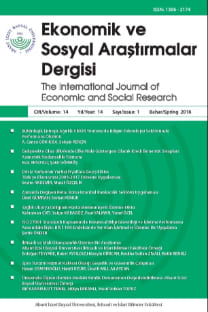TÜRKİYE’DE ENERJİ TÜKETİMİ vE İŞSİZLİK İLİŞKİSİ
ENERGY CONSUMPTION AND UNEMPLOYMENT NEXUS IN TURKEY
___
- Ahmad, F. (2013). The Effect of Oil Prices on Unemployment: Evidence from Pakistan, Business and Economics Research Journal, 4(1), 43-57.
- Akçacı, T. (2013). Eğitim Harcamalarının İktisadi Büyümeye Etkisi (The Influence of Education Expenditure on Economic Growth), Kafkas Üniversitesi İktisadi ve İdari Bilimler Fakültesi Dergisi, 4(5): 65-79.
- Bouchaour C., & Al-Zeaud H. A. (2012). Oil Price Distortion and Their Impact on Algerian Macroeconomic, International Journal of Business and Management, 7(18).
- Caporale, G. M., & Gil-Alana, L. A. (2002). Unemployment and Input Prices: A Fractional Cointegration Approach, Applied Economics Letters, 9(6), 347-351.
- Carruth, A. A., Hooker, M. A., & Oswald, A. J. (1998). Unemployment Equilibria and Input Prices Theory And Evidence From The United States, The Warwick Economics Research Paper Series (TWERPS), 496.
- Chang, Y., & Wong, J. F. (2003). Oil Price Fluctuations and Singapore Economy, Energy Policy, 31(1), 1151-1165.
- Chang, Y., Jha, K., Fernandez, K. M., & Jam’an, N. F. (2011). Oil Price Fluctuations and Macroeconomic Performance In Asian and Oceanic Economies, http://www.usaee.org/usaee2011/submissions/ OnlineProceedings/Chang%20et%20al_Full%20Paper.pdf, (28.08.2015).
- Çatık, A. N. (2006). Yapısal Kırılma Altında Para Talebinin İstikrarı: Türkiye Örneği (Money Demand Stability under The Stuctural Break: The Turkish Case), Ege Üniversitesi, Working Paper, No:06/11.
- Dadkhah, K. M., & Stijns, J. C. (2006). The Effects Of Political Instability In The Middle East and OPEC Production Policy On Oil Prices, http://www.luc.edu/orgs/meea/volume8/PDFS/Dadkhah.pdf, (28.08.2015).
- Doğrul, H. G., & Soytas, U. (2010). Relationship Between Oil Prices, Interest Rate, and Unemployment: Evidence From An Emerging Market, Energy Economics, 32(6), 1523-1528.
- Erkan, B., Şentürk, M., Akbaş, Y. E., & Bayat, T. (2011). The Effect on the Indicators of Unemployment of International Crude Oil Price Volatility: Empirical Findings on the Case of Turkey, Gaziantep Üniversitesi Sosyal Bilimler Dergisi, 10(2): 715-730.
- Estrada A., & Cos, P. H. D. (2012). Oil Prices and Their Effect On Potential Output, Applied Economics Letters, 19(3), 207-214.
- Ewing, B. T., & Thompson, M. A. (2007). Dynamic Cyclical Comovements Of Oil Prices With Industrial Production,Consumer Prices, Unemployment, and Stock Prices, Energy Policy, 35(11), 5535-5540.
- Gil-Alana, L. A., (2003). Unemployment and Real Oil Prices In Australia: A Fractionally Cointegrated Approach, Applied Economics Letters, 10(4), 201-204.
- Gregory, A.. W. & Hansen B. E. (1996). Residual-Based Tests For Cointegration in Models with Regime Shifts, Journal of Econometrics, 70 (1), 99-126.
- Hoag, J., & Wheeler, M. (1996). Oil Price Shocks and Employment: The Case Of Ohio Coal Mining, Energy, 18, 211-220.
- http://www.tuik.gov.tr/PreTablo.do?alt_id=1007
- https://www.bp.com/content/dam/bp/pdf/energy-economics/statistical-review-2016/bp-statisticalreview-of-world-energy-2016-full-report.pdf
- Keane, M. P., & Prasad, E. S. (1996). The Employment And Wage Effects Of Oil Price Changes A Sectoral Analysis, The Review of Economics and Statistics, 78(3), 389-400.
- Lescaroux, F. & Mignon, V. (2008). On the Influence of Oil Prices on Economic Activity and Other Macroeconomic and Financial Variables,Opec Energy Review, 32(4), 343-380.
- Loganathan, N., & Kogid, M. (2013). Connection between Global Oil Price Instability and Unemployment Sustainability: Empirical Evidence from Malaysia, The Empirical Economics Letters, 12(4), 393-402.
- Papapetrou, E. (2001). Oil Price Shocks, Stock Market, Economic Activity and Employment In Greece, Energy, 23(3), 511-532.
- Payne James E. (2009). On the Dynamics of Energy Consumption and Employment in Illinois, Journal of Regional Analysis and Policy, 39 (2), pp. 126-130.
- Rafiq, S., Salm, R., & Bloch, H. (2009). Impact of Crude Oil Price Volatility On Economic Activities: An Empirical Investigation In The Thai Economy, Resources Policy, 34(3), 121-132.
- Ran, J. & Voon, J. P. (2012). Does Oil price Shock Affect Small Open Economies? Evidence from Hong Kong, Singapore, South Korea and Taiwan, Applied Economics Letters, 19(16), 1599-1602.
- Robalo, P. B., & Salvado, J. C. (2008). Oil Price Shocks and The Portuguese Economy Since The 1970s, FEUNL Working Paper Series, 529.
- Tarı, R. (2010), Ekonometri, Genişletilmiş 6.baskı, Umuttepe Yayınları, Kocaeli.
- Tıraşoğlu, M. & Yıldırım B. (2012). Yapısal Kırılma Durumunda Sağlık Harcamaları ve Ekonomik Büyüme İlişkisi: Türkiye Üzerine Bir Uygulama (Health Expenditure and Economic Growth Relationship in The Case of Structural Break: A Case Study for Turkey), Electronic Journal of Vocational Colleges, 2 (2), 111-117.
- Toda, H. Y. & Yamamoto T. (1995). Statistical Inference In Vector Autoregressions With Possibly Integrated Processes, Journal of Econometrics, 66 (1-2), 225-250.
- Umar, G., & Abdulhakeem, K. A. (2010). Oil Price Shocks and Nigeria Economy: A Variance Autoregressive (VAR) Model, International Journal of Business and Management, 5(8).
- Uri, N. (1996). Crude Oil Price Volatility And Unemployment In The United States, Energy, 21(1), 29-38.
- Yahia, A. F. & Saleh, A.S., (2008). Economic Sanctions, Oil Price Fluctuations and Employment: New Empirical Evidence from Libya, American Journal Applied Sciences, 5(12), 1713-1719.
- Yılancı, V. & Özcan B. (2010). Yapısal Kırılmalar Altında Türkiye için Savunma Harcamaları ile GSMH Arasındaki İlişkinin Analizi (Analyzing the Relationship Between Defense Expenditures and GNP for Turkey Under Structural Breaks), C.Ü. İktisadi ve İdari Bilimler Dergisi, 11 (1), 21-33.
- ISSN: 1306-2174
- Yayın Aralığı: Yılda 2 Sayı
- Başlangıç: 2005
- Yayıncı: Abant İzzet Baysal Üniversitesi İktisadi ve İdari Bilimler Fakültesi
Türkiye’de Vergi Yükünün Değerlendirilmesi: OECD Ülkeleri ile Karşılaştırma
Harun KILIÇASLAN, Sercan YAVAN
ALTIN FİYATLARINI ETKİLEYEBİLECEK FAKTÖRLERİN İNCELENMESİ
İsmail KÜÇÜKAKSOY, Doğan YALÇIN
Altın Fiyatlarını Etkileyebilecek Faktörlerin İncelenmesi
İsmail KÜÇÜKAKSOY, Doğan YALÇIN
İŞLETMELERDE DUYGU GÖSTERİM KURALLARI VE ÖRGÜTSEL VATANDAŞLIĞIN DUYGUSAL EMEK ÜZERİNE ETKİLERİ
Meltem YALÇIN KAYIKÇI, Oğuz TÜRKAY
TÜRKİYE’DE VERGİ YÜKÜNÜN DEĞERLENDİRİLMESİ: OECD ÜLKELERİ İLE KARŞILAŞTIRMA
Harun KILIÇASLAN, Sercan YAVAN
Risk Management in Islamic Banks: Findings from Libya
Mine HALİS, Ahmed Elmabruk ABDSSALM ELTAWİL
İşletmelerde Duygu Gösterim Kuralları ve Örgütsel Vatandaşlığın Duygusal Emek Üzerine Etkileri
Oğuz TÜRKAY, Meltem YALÇIN KAYIKÇI
